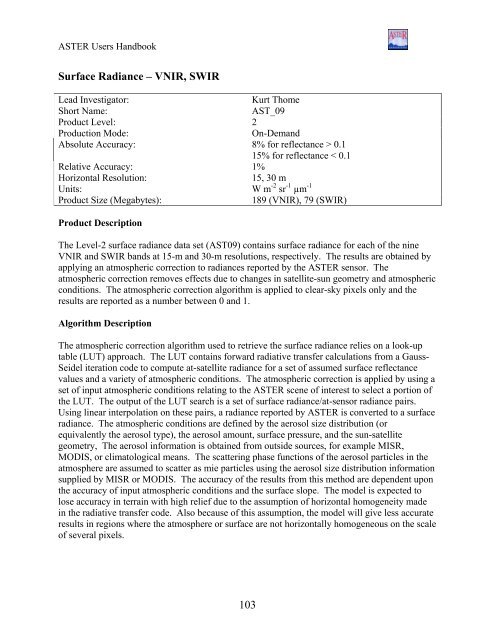Create successful ePaper yourself
Turn your PDF publications into a flip-book with our unique Google optimized e-Paper software.
<strong>ASTER</strong> Users HandbookSurface Radiance – VNIR, SWIRLead Investigator:Kurt ThomeShort Name:AST_09Product Level: 2Production Mode:On-DemandAbsolute Accuracy: 8% for reflectance > 0.115% for reflectance < 0.1Relative Accuracy: 1%Horizontal Resolution:15, 30 mUnits: W m -2 sr -1 µm -1Product Size (Megabytes):189 (VNIR), 79 (SWIR)Product DescriptionThe Level-2 surface radiance data set (AST09) contains surface radiance for each of the nineVNIR and SWIR bands at 15-m and 30-m resolutions, respectively. The results are obtained byapplying an atmospheric correction to radiances reported by the <strong>ASTER</strong> sensor. Theatmospheric correction removes effects due to changes in satellite-sun geometry and atmosphericconditions. The atmospheric correction algorithm is applied to clear-sky pixels only and theresults are reported as a number between 0 and 1.Algorithm DescriptionThe atmospheric correction algorithm used to retrieve the surface radiance relies on a look-uptable (LUT) approach. The LUT contains forward radiative transfer calculations from a Gauss-Seidel iteration code to compute at-satellite radiance for a set of assumed surface reflectancevalues and a variety of atmospheric conditions. The atmospheric correction is applied by using aset of input atmospheric conditions relating to the <strong>ASTER</strong> scene of interest to select a portion ofthe LUT. The output of the LUT search is a set of surface radiance/at-sensor radiance pairs.Using linear interpolation on these pairs, a radiance reported by <strong>ASTER</strong> is converted to a surfaceradiance. The atmospheric conditions are defined by the aerosol size distribution (orequivalently the aerosol type), the aerosol amount, surface pressure, and the sun-satellitegeometry, The aerosol information is obtained from outside sources, for example MISR,MODIS, or climatological means. The scattering phase functions of the aerosol particles in theatmosphere are assumed to scatter as mie particles using the aerosol size distribution informationsupplied by MISR or MODIS. The accuracy of the results from this method are dependent uponthe accuracy of input atmospheric conditions and the surface slope. The model is expected tolose accuracy in terrain with high relief due to the assumption of horizontal homogeneity madein the radiative transfer code. Also because of this assumption, the model will give less accurateresults in regions where the atmosphere or surface are not horizontally homogeneous on the scaleof several pixels.103















